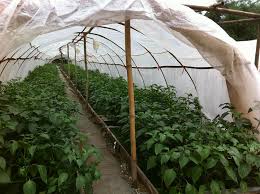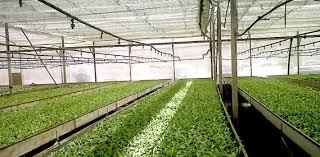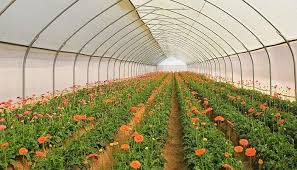Vegetable production in open fields faces many challenges such as heavy rain, thunderstorms, excessive solar radiation, temperatures and humidity levels above optimal for plant growth, high insect pest pressure, and fungal diseases.
To address these challenges, various protective cultivation practices have been adopted based on prevailing climatic conditions.
Among these, greenhouse or polyhouse cultivation is highly effective for year-round vegetable production in temperate regions.
Greenhouse protected cultivation operates on the principle known as the greenhouse effect.
A greenhouse is a structure covered with transparent materials like polythene or glass that transmit solar energy inside.
This energy is absorbed by the crops and objects inside, which then release long-wavelength light that cannot escape through the non-transparent cladding.
This traps light inside, increasing the internal temperature. This temperature rise enables vegetable cultivation in cold climates.
During summer, the temperature increase is managed through ventilation and cooling systems when temperatures exceed critical levels.
Read Also: How to Grow, Use and Care for Wildrye Grass (Elymus spp.)
Definition, Types, and Attributes of Greenhouses in Crop Production

A. Definition and Types of Greenhouses in Agriculture
A greenhouse is a framed or inflated structure covered with transparent or translucent material where crops are grown under at least partially controlled environmental conditions.
It is large enough to allow workers to perform cultural operations inside. This technique creates favorable growth conditions for plants.
The three major types of greenhouses include:
1. Forced Ventilated Greenhouse: Climate-controlled with cooling and heating systems, used for growing exotic vegetables, off-season vegetables, floriculture, planting material acclimatization, plant breeding, and varietal improvement under adverse agro-climatic conditions.
In forced ventilated greenhouses, the environment is adjusted to meet the specific needs of plants. This structure is essential for harnessing the full potential of protected cultivation technology.
Greenhouse technology provides a controlled environment for crop growth and high productivity throughout the year. These greenhouses range from basic to fully automated systems with double-walled polycarbonate roofing, heating, cooling, and computerized controls.
2. Naturally Ventilated Greenhouse: A cost-effective greenhouse version with vents at the top and sides, allowing air exchange based on temperature differences between inside and outside. These greenhouses rely on wind pressure to circulate air.
3. Fan Pad Greenhouse: Designed for controlled growing environments of special crops, equipped with fans that draw air through cooling pads and foggers to control humidity.
Fertigation is managed by drip irrigation. This type is ideal for nursery plants and crops grown for export or as import substitutes, such as carnation, gerbera, rose, colored capsicum, cucumber, and cherry tomato.
B. Important Attributes of Greenhouses
A greenhouse has four key attributes:
1. A framed or inflated structure.
2. Covered by transparent or translucent material to maintain optimum light levels.
3. Crop microclimate can be at least partially controlled.
4. Large enough for workers to perform operations inside.
Advantages and Disadvantages of Greenhouse Cultivation in Agriculture
A. Advantages of Greenhouses
1. Enables cultivation of four to five crops yearly due to controlled environmental conditions.
2. Significantly increases productivity and financial returns per unit area.
3. Produces superior quality crops due to controlled environments.
4. Efficient use of inputs like water, fertilizers, seeds, and pesticides.
5. Effective pest and disease control through enclosure.
6. Higher seed germination rates.
7. Facilitates acclimatization of tissue culture plantlets.
8. Allows scheduling of crop production to meet market demands.
9. Supports use of diverse growing media such as peat moss, vermiculite, rice hulls, and compost.
10. Produces export-quality crops meeting international standards.
11. Enables drying and post-harvest operations using trapped heat when crops are not grown.
12. Supports automation of irrigation and environmental controls with computer systems.
13. Creates self-employment opportunities for educated youth.
B. Disadvantages of Greenhouses
The major disadvantage is the high initial cost of construction and operation, which is a barrier for many farmers in developing countries. Additional challenges include:
1. High cost of climate control systems.
2. Need for uninterrupted power supply for cooling and heating.
3. Limited availability of quality cladding materials.
4. Lack of tools for efficient crop production inside greenhouses.
5. Insufficient research programs on greenhouse vegetable production.
6. Absence of breeding programs for varieties suitable for greenhouse cultivation.
7. High cost and limited availability of exotic seeds.
Read Also: How to Grow, Use and Care for Wilman Lovegrass (Eragrostis superba)
Environmental Variables and Their Control Inside Greenhouses for Crop Growth

Crop growth and productivity depend on heredity and the microclimate around the plant, which includes light, temperature, air composition, and root medium quality.
Open-field cultivation only allows manipulation of the root medium through tillage, irrigation, and fertilization. In greenhouses, one or more microclimate components can be controlled due to enclosed boundaries.
Greenhouses enable vegetable production during unfavorable weather conditions such as high temperature, flooding, and strong winds, which often increase disease incidence.
Inside greenhouses, temperature rises gradually due to trapped solar radiation. Cooling methods such as evaporative cooling, shading, and natural ventilation help manage excessive heat.
1. Light Management in Greenhouse Cultivation
Visible solar radiation provides energy for photosynthesis, which uses light energy, carbon dioxide, and water to produce carbohydrates essential for plant growth and reproduction. Photosynthesis efficiency depends on fertilizer availability, water, carbon dioxide, light, and temperature.
The photosynthesis reaction is:
Chlorophyll
CO₂ + water + light energy → carbohydrates + oxygen
Light intensity influences photosynthesis rate. Reduced light slows growth, while excessive light can damage chloroplasts. Plants use about 22% of available light.
Greenhouses transmit up to 80% of sunlight at noon and an average of 68% over the day. Crop rows are arranged to optimize light interception.
2. Temperature Control for Optimal Plant Growth
Temperature affects plant growth within specific ranges. Below optimal temperatures, ice formation damages tissues. Above optimal temperatures, enzymes become inactive, halting essential biochemical reactions. Enzymes catalyze plant biochemical processes and are heat-sensitive.
Generally, greenhouse crops are grown with day temperatures 3 to 6°C higher than night temperatures on cloudy days, and about 8°C higher on clear days. Night temperatures typically range from 7 to 21°C.
3. Relative Humidity Management in Greenhouses
Relative humidity (RH) inside greenhouses is higher than outside due to moisture from evapotranspiration. Ventilation removes some moisture, while sensible heat lowers RH. Desired RH ranges from 50 to 80% for most crops; up to 90% may be needed for propagation.
Summer heat and winter night heating reduce RH. Evaporative cooling pads and fogging systems add humidity. Ventilators, chemical dehumidifiers, and cooling coils reduce excess humidity.
4. Ventilation Systems in Greenhouse Cultivation
Ventilation reduces temperature, replenishes carbon dioxide, and moderates humidity. Temperatures above 35°C are unsuitable for most greenhouse crops. Ventilation can be natural or forced.
Natural ventilation suits small greenhouses (<6m wide) during spring and autumn, while fan ventilation provides precise control over temperature, humidity, and carbon dioxide levels.
6. Carbon Dioxide as a Critical Nutrient
Carbon is a vital nutrient present in plants in larger amounts than any other mineral. It plays a fundamental role in photosynthesis and crop growth.
Do you have any questions, suggestions, or contributions? If so, please feel free to use the comment box below to share your thoughts. We also encourage you to kindly share this information with others who might benefit from it. Since we can’t reach everyone at once, we truly appreciate your help in spreading the word. Thank you so much for your support and for sharing!

